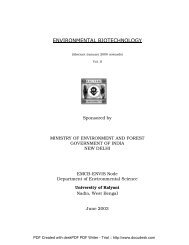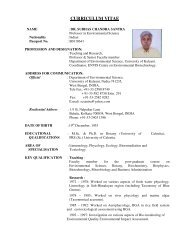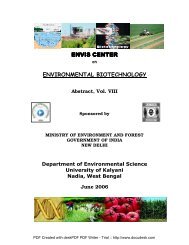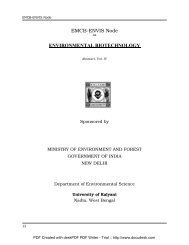EMCB-ENVIS Node ENVIRONMENTAL BIOTECHNOLOGY
EMCB-ENVIS Node ENVIRONMENTAL BIOTECHNOLOGY
EMCB-ENVIS Node ENVIRONMENTAL BIOTECHNOLOGY
Create successful ePaper yourself
Turn your PDF publications into a flip-book with our unique Google optimized e-Paper software.
<strong>EMCB</strong>-<strong>ENVIS</strong> Centre<br />
species growing on archaeologically important metalliferous spoil tips has indicated their ability<br />
to bioaccumulate heavy metals and sulfur primarily from the substratum; the bioaccumulation<br />
and biomagnification of lead and sulfur are particularly marked in both Acacia and Eucalyptus.<br />
The concentrations of elements in different parts of the two tree species are discussed and<br />
partitioning is noted together with the fact that while the pod of Acacia and the fruit capsule of<br />
Eucalyptus may have an enhanced metal loading, the values in the seeds are much reduced; the<br />
importance of this is discussed. The seeds of Acacia differ chemically from those of Eucalyptus.<br />
The importance of these plants as biomonitors of environmental quality is noted.<br />
G. Gorbi, M. G. Corradi, M. Invidia, M. Bassi. (Department of Environmental Sciences,<br />
University of Parma, I-43100, Parma, Italy. Department of Evolutive and Functional<br />
Biology, University of Parma, I-43100, Parma, Italy). Light Intensity Influences<br />
Chromium Bioaccumulation and Toxicity in Scenedesmus acutus (Chlorophyceae).<br />
Ecotoxicology and Environmental Safety, 48(1) (2001), 36-42.<br />
The influence of light intensity on chromium uptake was studied in two strains of the freshwater<br />
unicellular alga Scenedesmus acutus (Chlorophyceae) having different sensitivity to Cr<br />
poisoning and light intensity. The two strains were subjected to different Cr treatments at 3000<br />
and 80 lux. Cr toxicity was assessed by algal growth rate, recovery test, methylene blue staining,<br />
and determination of photosynthetic activity. After 2 and 4 days of treatment, bioaccumulated<br />
chromium, cell dry mass, and protein and carbohydrate contents were also assessed. When the<br />
algae were treated at 3000 lux, different bioaccumulation patterns were obtained when Cr<br />
content was related to dry mass, cell number, or protein content. A direct relationship between<br />
Cr content and cell mortality was observed only when the amount of Cr was related to protein<br />
content. In both strains Cr uptake was slower in subdued light, suggesting that it is linked to<br />
energy-dependent processes. The difference between the strains in sensitivity to Cr poisoning<br />
was also evident in subdued light.<br />
G. R. MacFarlane, A. Pulkownik and M. D. Burchett. (School of Environmental and Life<br />
Sciences, University of Newcastle, Callaghan, NSW, 2308, Australia. Centre for<br />
Ecotoxicology and Department of Environmental Sciences, University of Technology,<br />
Sydney, Gore Hill, NSW 2065, Australia). Accumulation and distribution of heavy<br />
metals in the grey mangrove, Avicennia marina (Forsk.)Vierh.: biological<br />
indication potential. Environmental Pollution, 123(1) (2003), 139-151.<br />
The accumulative partitioning of the heavy metals Cu, Pb and Zn in the grey mangrove,<br />
Avicennia marina, were studied under field conditions. Copper and Pb were accumulated in root<br />
tissue to levels higher than surrounding sediment levels. Zinc was accumulated to levels<br />
reflecting sediment concentrations. Strong linear relationships existed for all metals in sediments<br />
with metals in root tissue. Accumulation of Cu in leaf tissue followed a linear relationship at<br />
lower sediment concentrations, with an exclusion or saturation mechanism at higher sediment<br />
concentrations. Lead showed little mobility to leaf tissue. Zn showed restricted accumulation in<br />
leaf tissue, which correlated with sediment concentrations. Decreases in sediment pH were found<br />
to increase Zn accumulation to root tissue. Increasing concentrations of Pb and Zn in sediments<br />
resulted in a greater accumulation of Pb to both root and leaf tissue. A. marina roots may be<br />
employed as a biological indicator of environmental exposure of Cu, Pb and Zn and leaves for<br />
Zn, with temporal monitoring.<br />
Gregorio Fernandez-Leborans and Yolanda Olalla Herrero. (Departamento de Biologia<br />
Animal I (Zoologia), Pnta. 9 a , Universidad Complutense, 28040, Madrid, Spain). Toxicity<br />
and Bioaccumulation of Lead and Cadmium in Marine Protozoan Communities.<br />
Ecotoxicology and Environmental Safety, 47(3) (2000), 266-276.<br />
26<br />
PDF Created with deskPDF PDF Writer - Trial :: http://www.docudesk.com







